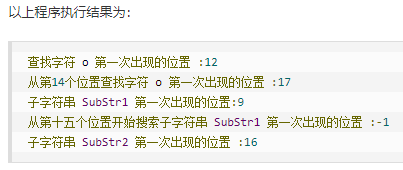パブリック クラスStringDemo {
公共 静的 ボイドメイン(文字列引数[]){
CHAR [] helloArray = {R ''、 'U'、 'N'、 'O'、 'O'、 'B' }。
文字列helloString = 新しい文字列(helloArray)。
System.out.println(helloString)。
}
}
パブリック クラスStringDemo {
公共 静的 ボイドメイン(文字列引数[]){
文字列サイト = "www.runoob.com" ;
int型 LEN = site.length();
のSystem.out.println( "チュートリアル初心者URLの長さ:" + LEN );
}
}
パブリック クラスStringDemo {
公共 静的 ボイドメイン(文字列引数[]){
文字列の文字列1 = "チュートリアル初心者URL:" ;
のSystem.out.println( "1" +文字列1 + "www.runoob.com" );
}
}
System.out.printf( "変数値フロート" +
"%F、整数変数の値が" +
"の文字列変数の値の%のD、" +
"%sである"、floatVar、IntVar、 STRINGVAR);
FS文字列;
FS = String.Formatの( "変数値フロート" +
"%F、整数変数の値が" +
"の文字列変数の値の%のD、" +
"%S"、floatVar、 intVar、STRINGVAR)。
パブリック クラスのテスト{
公共 静的 ボイドメイン(文字列引数[]){
文字列S =「www.runoob.com」。
チャー結果= s.charAt(8 )。
System.out.println(結果)。
}
}
パブリック クラスのテスト{
公共 静的 ボイドメイン(文字列引数[]){
文字列STR1 =「文字列」。
文字列STR2 = "文字列" ;
文字列STR3 = "Strings123" 。
int型の結果= str1.compareTo(STR2)。
System.out.println(結果)。
結果 = str2.compareTo(STR3)。
System.out.println(結果)。
結果 = str3.compareTo(0009)。
System.out.println(結果)。
}
}
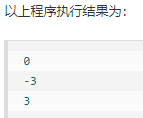
パブリック クラスのテスト{
公共 静的 ボイドメイン(文字列引数[]){
文字列STR1 =「STRINGS」。
文字列STR2 = "文字列" ;
文字列STR3 = "Strings123" 。
int型の結果= str1.compareToIgnoreCase(STR2)。
System.out.println(結果)。
結果 = str2.compareToIgnoreCase(STR3)。
System.out.println(結果)。
結果 = str3.compareToIgnoreCase(0009)。
System.out.println(結果)。
}
}
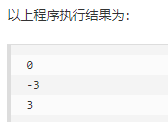
パブリック クラスのテスト{
公共 静的 ボイドメイン(文字列引数[]){
文字列S =「菜鸟教程:」。
S = s.concat( "www.runoob.com" )。
System.out.println(S);
}
}
パブリック クラスのテスト{
公共 静的 ボイドメイン(文字列引数[]){
文字列STR1 =「文字列1」。
文字列STR2 =「文字列2」。
StringBufferのSTR3 = 新しい StringBufferの( "文字列1" );
ブール 結果= str1.contentEquals(STR3)。
System.out.println(結果)。
結果 = str2.contentEquals(STR3)。
System.out.println(結果)。
}
}

パブリック クラスのテスト{
公共 静的 ボイドメイン(文字列引数[]){
CHAR []技研= { 'H'、 'E'、 'L'、 'L'、 'O'、 ''、 'R&LT'、「U '' N- '' O '' O '' B ' };
で文字列STR2 = "" ;
でSTR2 = Str2.copyValueOf(技研)
のSystem.out.println( "リターン結果:" + でSTR2);
STR2で Str2.copyValueOf =(技研、2 ,. 6 )
のSystem.out.println( "リターン結果:" + でSTR2);
}
}
パブリック クラスのテスト{
公共 静的 ボイドメイン(文字列引数[]){
文字列strが = 新しい新規の文字列( "初心者チュートリアル:www.runoob.com" );
ブールRETVAL;
RETVAL = Str.endsWith( "runoob" )
のSystem.out .println( "戻り値=" + RETVAL);
RETVAL = Str.endsWith( "COM" )
のSystem.out.println( "戻り値=" + RETVAL);
}
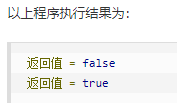
パブリック クラスのテスト{
公共 静的 ボイドメイン(文字列引数[]){
文字列STR1 = 新しい文字列(「runoob」)。
文字列STR2 = STR1。
文字列STR3 = 新しい文字列( "runoob" );
ブールRETVAL;
RETVAL = Str1.equals(STR2)。
System.out.println( "返回值=" + RETVAL)。
RETVAL = Str1.equals(STR3)。
System.out.println( "返回值=" + RETVAL)。
}
}
パブリック クラスのテスト{
公共 静的 ボイドメイン(文字列引数[]){
文字列STR1 = 新しい文字列(「runoob」)。
文字列STR2 = STR1。
文字列STR3 = 新しい文字列( "runoob" );
文字列STR4 = 新しい文字列( "RUNOOB" );
ブールRETVAL;
RETVAL = Str1.equals(STR2)。
System.out.println( "返回值=" + RETVAL)。
RETVAL = Str3.equals(STR4)。
のSystem.out.println( "戻り値=" + RETVAL);
RETVAL = Str1.equalsIgnoreCase(STR4)
のSystem.out.println( "戻り値=" + RETVAL);
}
}
輸入 java.io. * ;
パブリック クラスのテスト{
公共 静的 ボイドメイン(文字列引数[]){
文字列STR1 = 新しい文字列(「runoob」)。
試す{
バイト [] STR2 = Str1.getBytes()。
System.out.println( "返回值:" + STR2)。
STR2 = Str1.getBytes( "UTF-8" )。
System.out.println( "返回值:" + STR2)。
STR2 = Str1.getBytes( "ISO-8859-1" );
System.out.println( "返回值:" +STR2);
} キャッチ(にUnsupportedEncodingException E){
するSystem.out.println( "サポートされていない文字セット" );
}
}
}
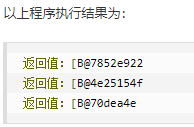
パブリック クラスのテスト{
公共 静的 ボイドメイン(文字列引数[]){
文字列技研は = 新しい新しい文字列( "www.runoob.com" );
char型の[] = STR2を新しい新しい チャー [6 ];
試み{
Str1.getChars( 4、10。 、0、でSTR2 );
System.out.print(の "コピー列" );
のSystem.out.println)における(STR2は;
} キャッチ(例外EX){
するSystem.out.println(「例外がトリガされ... " );
}
}
}
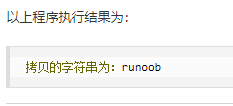
パブリック クラスのテスト{
公共 静的 ボイドメイン(文字列引数[]){
文字列strが = 新しい新しい文字列(「www.runoob.com」);
のSystem.out.printlnは(「ハッシュコード列である:」+ Str.hashCode ());
}
}

public class Main {
public static void main(String args[]) {
String string = "aaa456ac";
//查找指定字符是在字符串中的下标。在则返回所在字符串下标;不在则返回-1.
System.out.println(string.indexOf("b")); // indexOf(String str); 返回结果:-1,"b"不存在
// 从第四个字符位置开始往后继续查找,包含当前位置
System.out.println(string.indexOf("a",3));//indexOf(String str, int fromIndex); 返回结果:6
//(与之前的差别:上面的参数是 String 类型,下面的参数是 int 类型)参考数据:a-97,b-98,c-99
// 从头开始查找是否存在指定的字符
System.out.println(string.indexOf(99));//indexOf(int ch);返回结果:7
System.out.println(string.indexOf('c'));//indexOf(int ch);返回结果:7
//从fromIndex查找ch,这个是字符型变量,不是字符串。字符a对应的数字就是97。
System.out.println(string.indexOf(97,3));//indexOf(int ch, int fromIndex); 返回结果:6
System.out.println(string.indexOf('a',3));//indexOf(int ch, int fromIndex); 返回结果:6
}
}

public class Test {
public static void main(String args[]) {
String Str = new String("菜鸟教程:www.runoob.com");
String SubStr1 = new String("runoob");
String SubStr2 = new String("com");
System.out.print("查找字符 o 第一次出现的位置 :" );
System.out.println(Str.indexOf( 'o' ));
System.out.print("从第14个位置查找字符 o 第一次出现的位置 :" );
System.out.println(Str.indexOf( 'o', 14 ));
System.out.print("子字符串 SubStr1 第一次出现的位置:" );
System.out.println( Str.indexOf( SubStr1 ));
System.out.print("从第十五个位置开始搜索子字符串 SubStr1 第一次出现的位置 :" );
System.out.println( Str.indexOf( SubStr1, 15 ));
System.out.print("子字符串 SubStr2 第一次出现的位置 :" );
System.out.println(Str.indexOf( SubStr2 ));
}
}
